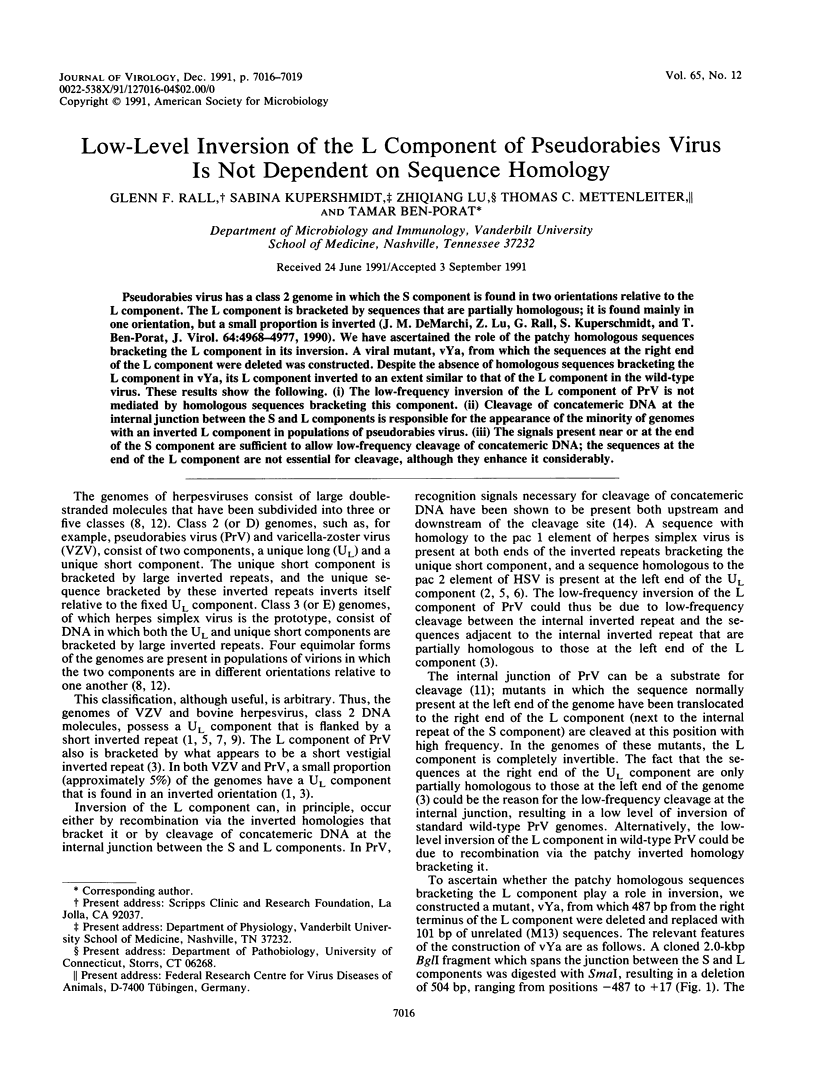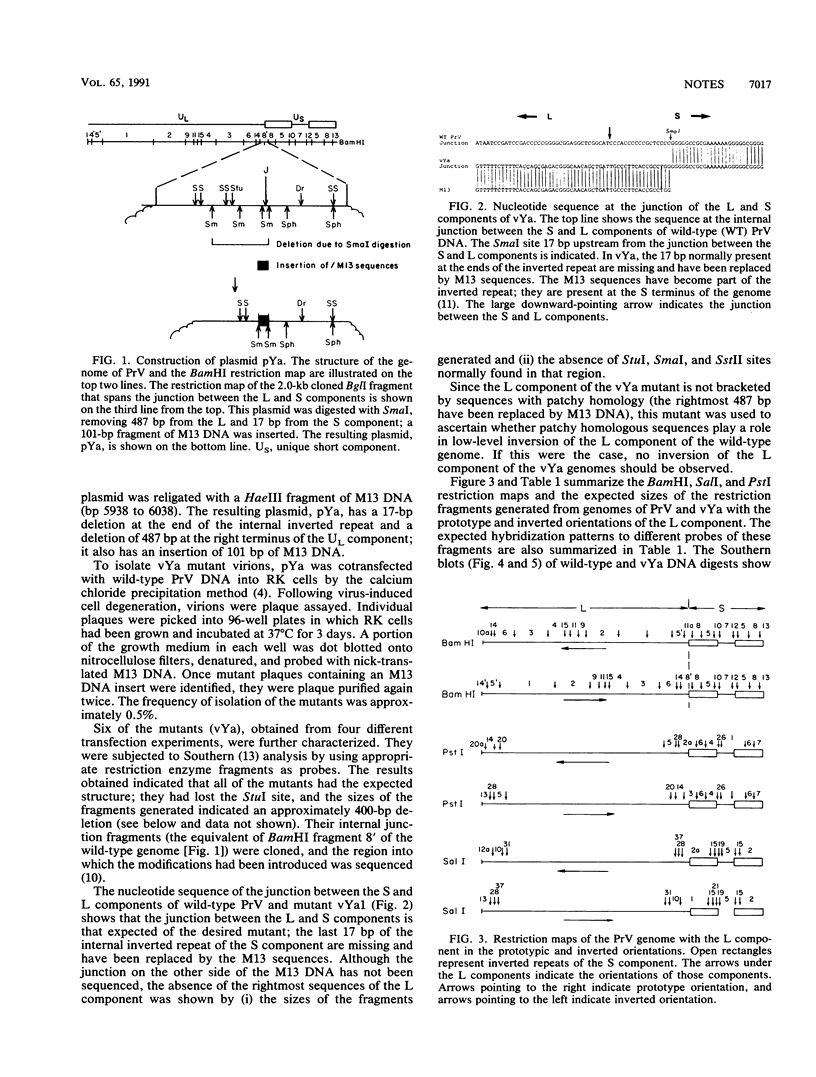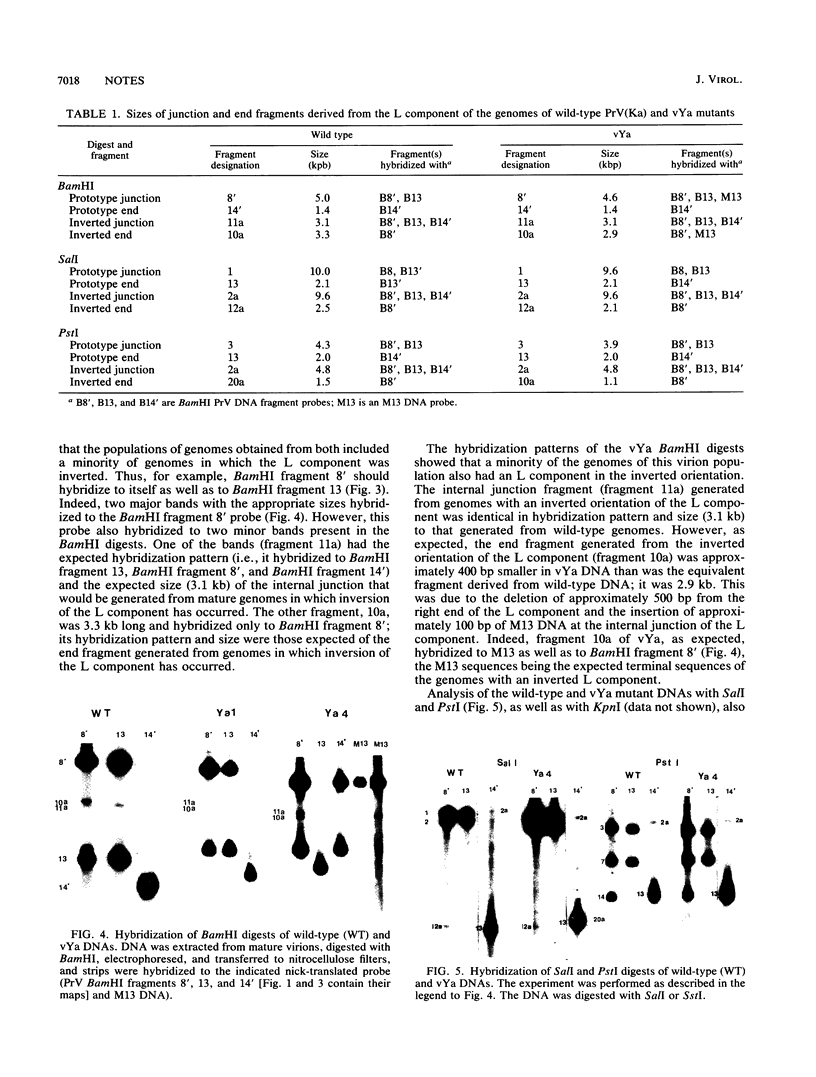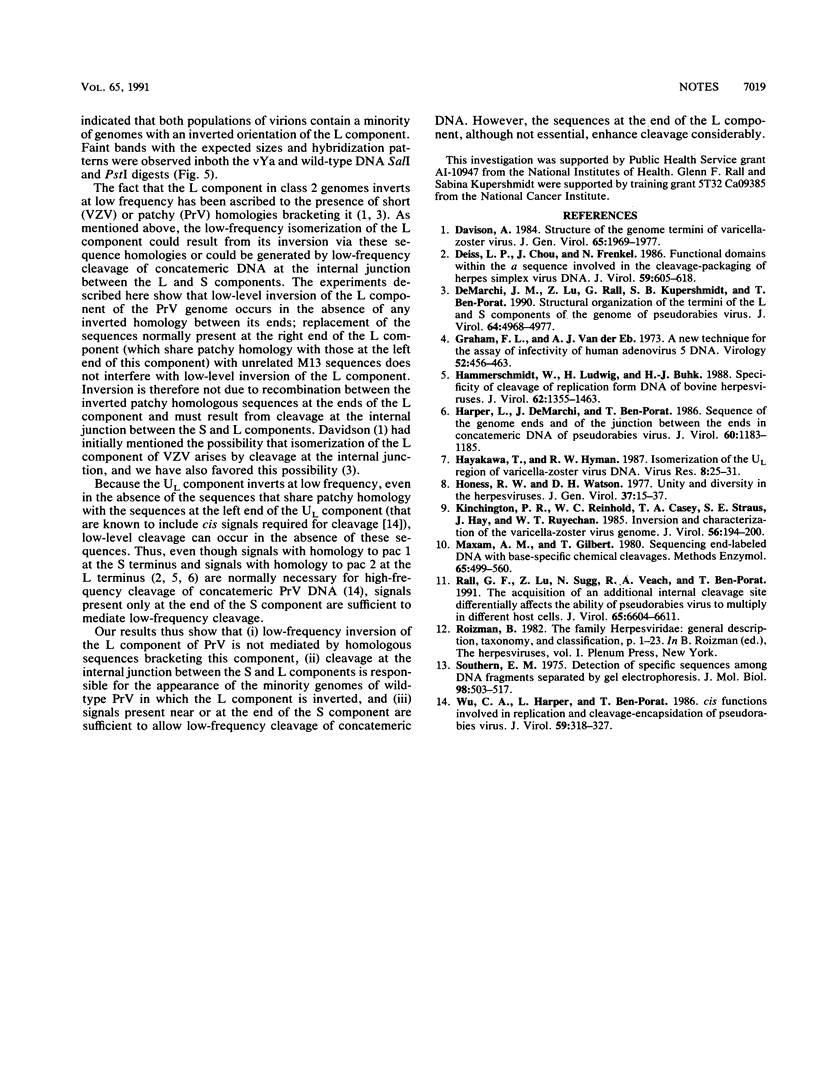Abstract
Pseudorabies virus has a class 2 genome in which the S component is found in two orientations relative to the L component. The L component is bracketed by sequences that are partially homologous; it is found mainly in one orientation, but a small proportion is inverted (J. M. DeMarchi, Z. Lu, G. Rall, S. Kuperschmidt, and T. Ben-Porat, J. Virol. 64:4968-4977, 1990). We have ascertained the role of the patchy homologous sequences bracketing the L component in its inversion. A viral mutant, vYa, from which the sequences at the right end of the L component were deleted was constructed. Despite the absence of homologous sequences bracketing the L component in vYa, its L component inverted to an extent similar to that of the L component in the wild-type virus. These results show the following. (i) The low-frequency inversion of the L component of PrV is not mediated by homologous sequences bracketing this component. (ii) Cleavage of concatemeric DNA at the internal junction between the S and L components is responsible for the appearance of the minority of genomes with an inverted L component in populations of pseudorabies virus. (iii) The signals present near or at the end of the S component are sufficient to allow low-frequency cleavage of concatemeric DNA; the sequences at the end of the L component are not essential for cleavage, although they enhance it considerably.
Full text
PDF



Images in this article
Selected References
These references are in PubMed. This may not be the complete list of references from this article.
- Davison A. J. Structure of the genome termini of varicella-zoster virus. J Gen Virol. 1984 Nov;65(Pt 11):1969–1977. doi: 10.1099/0022-1317-65-11-1969. [DOI] [PubMed] [Google Scholar]
- DeMarchi J. M., Lu Z. Q., Rall G., Kupershmidt S., Ben-Porat T. Structural organization of the termini of the L and S components of the genome of pseudorabies virus. J Virol. 1990 Oct;64(10):4968–4977. doi: 10.1128/jvi.64.10.4968-4977.1990. [DOI] [PMC free article] [PubMed] [Google Scholar]
- Deiss L. P., Chou J., Frenkel N. Functional domains within the a sequence involved in the cleavage-packaging of herpes simplex virus DNA. J Virol. 1986 Sep;59(3):605–618. doi: 10.1128/jvi.59.3.605-618.1986. [DOI] [PMC free article] [PubMed] [Google Scholar]
- Graham F. L., van der Eb A. J. A new technique for the assay of infectivity of human adenovirus 5 DNA. Virology. 1973 Apr;52(2):456–467. doi: 10.1016/0042-6822(73)90341-3. [DOI] [PubMed] [Google Scholar]
- Hammerschmidt W., Ludwig H., Buhk H. J. Specificity of cleavage in replicative-form DNA of bovine herpesvirus 1. J Virol. 1988 Apr;62(4):1355–1363. doi: 10.1128/jvi.62.4.1355-1363.1988. [DOI] [PMC free article] [PubMed] [Google Scholar]
- Harper L., Demarchi J., Ben-Porat T. Sequence of the genome ends and of the junction between the ends in concatemeric DNA of pseudorabies virus. J Virol. 1986 Dec;60(3):1183–1185. doi: 10.1128/jvi.60.3.1183-1185.1986. [DOI] [PMC free article] [PubMed] [Google Scholar]
- Hayakawa Y., Hyman R. W. Isomerization of the UL region of varicella-zoster virus DNA. Virus Res. 1987 Jul;8(1):25–31. doi: 10.1016/0168-1702(87)90037-2. [DOI] [PubMed] [Google Scholar]
- Honess R. W., Watson D. H. Unity and diversity in the herpesviruses. J Gen Virol. 1977 Oct;37(1):15–37. doi: 10.1099/0022-1317-37-1-15. [DOI] [PubMed] [Google Scholar]
- Kinchington P. R., Reinhold W. C., Casey T. A., Straus S. E., Hay J., Ruyechan W. T. Inversion and circularization of the varicella-zoster virus genome. J Virol. 1985 Oct;56(1):194–200. doi: 10.1128/jvi.56.1.194-200.1985. [DOI] [PMC free article] [PubMed] [Google Scholar]
- Maxam A. M., Gilbert W. Sequencing end-labeled DNA with base-specific chemical cleavages. Methods Enzymol. 1980;65(1):499–560. doi: 10.1016/s0076-6879(80)65059-9. [DOI] [PubMed] [Google Scholar]
- Rall G. F., Lu Z. Q., Sugg N., Veach R. A., Ben-Porat T. Acquisition of an additional internal cleavage site differentially affects the ability of pseudorabies virus to multiply in different host cells. J Virol. 1991 Dec;65(12):6604–6611. doi: 10.1128/jvi.65.12.6604-6611.1991. [DOI] [PMC free article] [PubMed] [Google Scholar]
- Southern E. M. Detection of specific sequences among DNA fragments separated by gel electrophoresis. J Mol Biol. 1975 Nov 5;98(3):503–517. doi: 10.1016/s0022-2836(75)80083-0. [DOI] [PubMed] [Google Scholar]
- Wu C. A., Harper L., Ben-Porat T. cis Functions involved in replication and cleavage-encapsidation of pseudorabies virus. J Virol. 1986 Aug;59(2):318–327. doi: 10.1128/jvi.59.2.318-327.1986. [DOI] [PMC free article] [PubMed] [Google Scholar]




